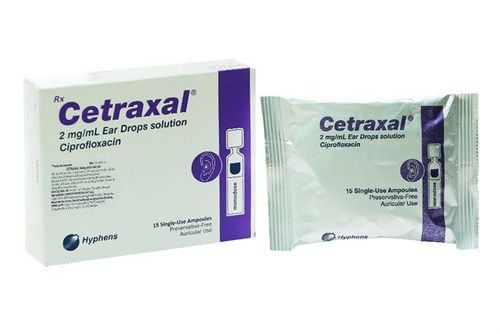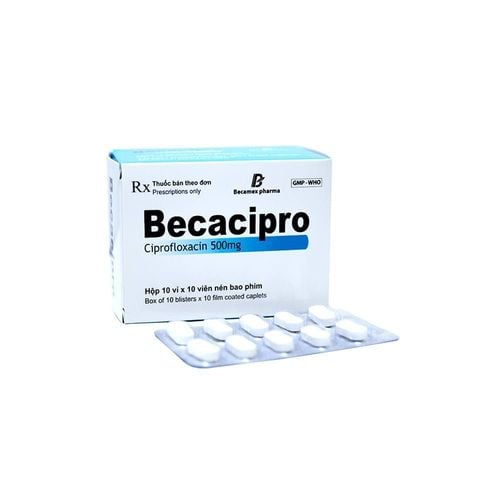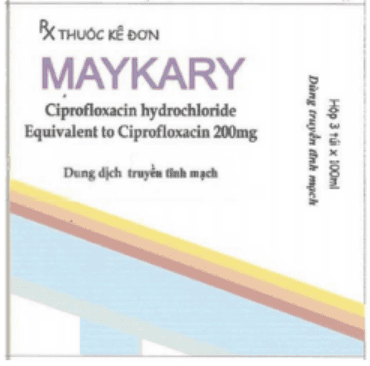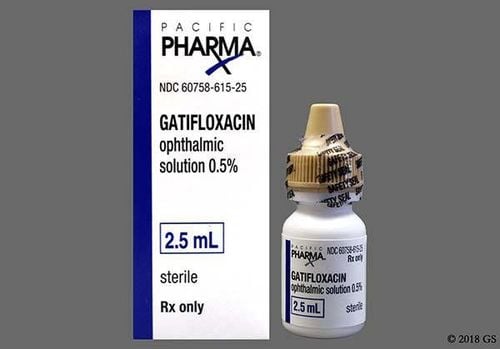This is an automatically translated article.
Ciprofloxacin Polpharma has the main active ingredient is Ciprofloxacin, which is a semi-synthetic antibiotic of the quinolone group. Ciprofloxacin Polpharma is indicated for bacterial infections such as upper and lower urinary tract infections, prostatitis, osteomyelitis, bacterial enteritis,...
1. What is Ciprofloxacin Polpharma?
What is Ciprofloxacin Polpharma? Ciprofloxacin Polpharma drug with active ingredient is Ciprofloxacin, a semi-synthetic antibiotic belonging to the quinolone group. The drug is prepared in the form of an infusion solution with a concentration of 2mg/ml, each bag contains 200ml of solution equivalent to Ciprofloxacin 400mg. The mechanism of action of Ciprofloxacin is to inhibit the enzyme topoisomerase II and/or topoisomerase IV, which are essential enzymes involved in the replication and transcription of bacterial DNA. Ciprofloxacin has good effect on bacteria resistant to antibiotics of other groups such as aminoglycosides, tetracyclines, cephalosporins, penicillins.... Ciprofloxacin is considered one of the powerful drugs in the fluoroquinolone group.
2. Uses of Ciprofloxacin Polpharma
Ciprofloxacin Polpharma is indicated for infections caused by susceptible bacteria, including:
Upper urinary tract infections and lower urinary tract infections Prostatitis Osteoarthritis Osteoarthritis Bacterial enteritis Severe hospital-acquired infections (bacteremia, immunocompromised patients). Bronchitis, pneumonia. Chronic purulent otitis media, malignant otitis externa. Acute exacerbation of chronic sinusitis, especially caused by Gram-negative bacteria. Epididymitis Pelvic inflammatory disease including cases caused by Neisseria gonorrhoeae Intra-abdominal infections. Skin and soft tissue infections caused by gram-negative bacteria. Prophylaxis of meningococcal disease and bacterial infections in immunocompromised individuals.
3. Contraindications of Ciprofloxacin Polpharma
Ciprofloxacin Polpharma is contraindicated in the following cases:
Patients with a history of hypersensitivity to ciprofloxacin and other quinolone antibiotics. Pregnant and lactating patients, unless required
4. Dosage of Ciprofloxacin Polpharma
4.1 Dosage Dosage depends on indications, severity, site of infection and renal function of the patient. Below is a reference dose of Ciprofloxacin in some cases:
Bone and joint infections: In mild to moderate cases, the dose is 400mg/time, every 12 hours for 4-6 weeks. In severe cases/complications, the recommended dose is 400mg/time, every 8 hours for 4-6 weeks. Endocarditis caused by HACEK bacteria: Ciprofloxacin should be indicated only if treatment with beta-lactam antibiotics is not effective. The recommended dose is 400mg once every 12 hours for 4 weeks. Fever due to neutropenia: The usual dose is 400mg/time, every 8 hours, for 7-14 days. Intra-abdominal infections: The usual dose is 400 mg/time, every 12 hours, for 7-14 days. Lower respiratory tract infections: Mild to moderate disease, dose 400mg/time, every 12 hours, for 7-14 days. In case of severe disease/complications, dose 400mg/time, every 8 hours, for 7-14 days. Nosocomial pneumonia: The usual dose is 400mg/time, every 8 hours, for 10-14 days. Skin and skin structure infections: Mild to moderate disease, 400mg once every 12 hours for 7-14 days. In case of severe disease/complications, dose 400mg/time, every 8 hours, for 7-14 days. Typhoid: The recommended dose is 400mg/time, every 12 hours, for 10-14 days. Urinary tract infections: Uncomplicated (including cystitis): The recommended dose is 400mg/time, every 12 hours and used for 7-14 days. Complications (including pyelonephritis): The recommended dose is 400mg once every 12 hours for 7-14 days. Patients with hepatic impairment: No dose adjustment of Ciprofloxacin is required in patients with hepatic impairment. Patients with renal impairment: The dose of Ciprofloxacin should be adjusted according to the patient's glomerular filtration rate. Children: Ciprofloxacin Polpharma is not recommended for children and adolescents under 18 years of age, unless absolutely necessary. 4.2 How to use Ciprofloxacin Polpharma is administered by intravenous infusion. The infusion time for children is usually 60 minutes. The infusion time in adult patients is a minimum of 60 minutes for ciprofloxacin 400mg/200ml solution for infusion or a minimum of 30 minutes for ciprofloxacin 200mg/100ml.
5. Side effects of Ciprofloxacin Polpharma
When using Ciprofloxacin Polpharma, patients may experience the following side effects:
Frequency > 10%: Neuromusculoskeletal: Musculoskeletal pain
Frequency 1 to 10%:
Dermatology: Skin rash Gastrointestinal: Abdominal pain, diarrhea, bloating, nausea, vomiting Genital: Vaginal candidiasis Nervous system: Dizziness, drowsiness, headache, insomnia, anxiety, restlessness Respiratory: Asthma Other: Fever Frequency <1%:
Cardiovascular: Acute myocardial infarction, angina pectoris, bradycardia, flushing, hypertension, syncope Dermatology: Skin allergy, erythema multiforme, dermatitis exfoliative, maculopapular rash, pruritus, photosensitivity, Stevens-Johnson syndrome, toxic epidermal necrolysis, urticaria, vesicular dermatitis Endocrine and metabolic: Albuminuria, gynecomastia, increased Blood sugar Digestive: Abdominal pain, anorexia, Clostridium difficile colitis, constipation, gastrointestinal disturbances, flatulence, gastrointestinal bleeding, intestinal obstruction, oral mucosal ulceration Genitourinary system: Blood in urine, pain dysmenorrhea, vaginitis Hematology: Agranulocytosis, prothrombin time Prolonged, purpura Liver: Cholestatic jaundice, hepatic necrosis Hypersensitivity: Anaphylaxis, angioedema Nervous system: Hallucinations, hypertonia, malaise, mania, migraine, myasthenia gravis, nightmare.
6. Notes when using Ciprofloxacin Polpharma
Ciprofloxacin should be used with caution in patients with a history of seizures, central nervous system disorders, impaired liver or kidney function, glucose 6 phosphate dehydrogenase deficiency, myasthenia gravis. Long-term use of Ciprofloxacin may cause overgrowth of non-susceptible organisms. In particular, it is necessary to monitor the patient and make an antibiotic chart to take appropriate treatment according to the antibiotic chart. Using Ciprofloxacin may cause tests for Mycobacterium tuberculosis to be false negative. Ciprofloxacin may cause dizziness, thus affecting the ability to drive vehicles, operate machinery and other activities requiring alertness. Limit the use of Ciprofloxacin antibiotic for young children and growing children because the drug can cause cartilage degeneration in load-bearing joints. Pregnancy: Ciprofloxacin Polpharma should only be used in pregnant patients in case of severe infections for which there is no alternative antibiotic. Lactation: Ciprofloxacin is present in breast milk. Therefore, the drug should not be administered to a nursing patient, as the drug may accumulate in milk and reach concentrations harmful to the infant. If ciprofloxacin must be administered to the mother, breast-feeding must be discontinued.7. Ciprofloxacin Polpharma Drug Interactions
Concomitant use of Ciprofloxacin with some drugs may reduce efficacy or increase toxicity. Therefore, patients need to inform their doctor or pharmacist of all medicines, dietary supplements, herbs, being used for advice. Here are some notable drug interactions of Ciprofloxacin:
Concurrent use of Ciprofloxacin with non-steroidal anti-inflammatory drugs such as ibuprofen, indomethacin may increase the side effects of Ciprofloxacin. Antacids containing aluminum/magnesium, sucralfate, metal ions, multivitamins when used concurrently with Ciprofloxacin may reduce the absorption of levofloxacin. Antidiabetic drugs: Quinolone antibiotics may enhance or decrease the effect of antidiabetic drugs. Therefore, it is necessary to monitor blood glucose when using Ciprofloxacin in diabetic patients. Therefore, these drugs should be taken at least 2 hours apart from Ciprofloxacin. The absorption of ciprofloxacin may be reduced if certain cytotoxic drugs are used concurrently, such as cyclophosphamide, doxorubicin, vincristine, cytosine arabinoside, mitozantrone. Ciprofloxacin concentrations are significantly reduced if co-administered with didanosine. Therefore, Ciprofloxacin should be taken 2 hours before didanosine or 6 hours after didanosine. Above is information about uses, dosage and precautions when using Ciprofloxacin Polpharma. To prevent side effects and ensure the effectiveness of the drug, patients need to consult a medical professional before taking.
Follow Vinmec International General Hospital website to get more health, nutrition and beauty information to protect the health of yourself and your loved ones in your family.
Please dial HOTLINE for more information or register for an appointment HERE. Download MyVinmec app to make appointments faster and to manage your bookings easily.













